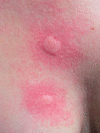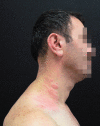Urticaria: its history-based diagnosis and etiologically oriented treatment
- PMID: 19626183
- PMCID: PMC2696901
- DOI: 10.3238/arztebl.2008.0458
Urticaria: its history-based diagnosis and etiologically oriented treatment
Abstract
Introduction: The term "urticaria" refers to any of a group of distinct skin conditions that are characterized by itchy, wheal-and-flare skin reactions (hives). In spontaneous urticaria, the most common type, the hives seem to arise without provocation.
Methods: Selective review of the literature, including current guidelines.
Results: Spontaneous urticaria is divided into acute (lasting less than six weeks) and chronic types. The pathognomonic itching, hives, and angioedema arise by the same mechanism--cutaneous mast cell activation and release of histamine and other mediators of inflammation--in both acute and chronic urticaria, but these two disorders have different etiological profiles. The underlying cause of acute urticaria cannot be identified in about half of all cases. Chronic urticaria, which is much rarer, is usually caused by autoreactivity, chronic infection, or intolerance to food additives. If the condition persists after the underlying cause has been treated or eliminated, non-sedating antihistamines are the agents of first choice for symptomatic treatment.
Discussion: Unlike acute urticaria, which is self-limited and should be treated symptomatically, chronic urticaria should be treated by the identification and elimination of underlying causes, which is usually curative.
Keywords: acute urticaria; antihistamines; chronic urticaria; hives; mast cells.
Figures




References
-
- Joint Task Force on Practice Parameters: The diagnosis and management of urticaria: a practice parameter. Part II: chronic urticaria/angioedema. Ann Allergy Asthma Immunol. 2000;85:532–544. - PubMed
-
- Maurer M, Siebenhaar F, Syska W, Magerl M. Ätiopathogenese der akuten und der chronischen Urtikaria. Allergo J. 2006;15:199–204.
-
- Maintz L, Bieber T, Novak N. Die verschiedenen Gesichter der Histaminintoleranz: Konsequenzen für die Praxis. Dtsch Arztebl. 2006;103(51-52):A 3477–A 3483.
-
- Champion RH, Roberts SOB, Carpenter RG, Riger JH. Urticaria and angioedema: a review of 554 patients. Br J Dermatol. 1969;81:588–597. - PubMed
-
- Zuberbier T, Iffländer J, Semmler C, Czarnetzki BM. Acute urticaria - clinical aspects and therapeutical responsiveness. Acta Derm Venereol. 1996;76:295–297. - PubMed
LinkOut - more resources
Full Text Sources

